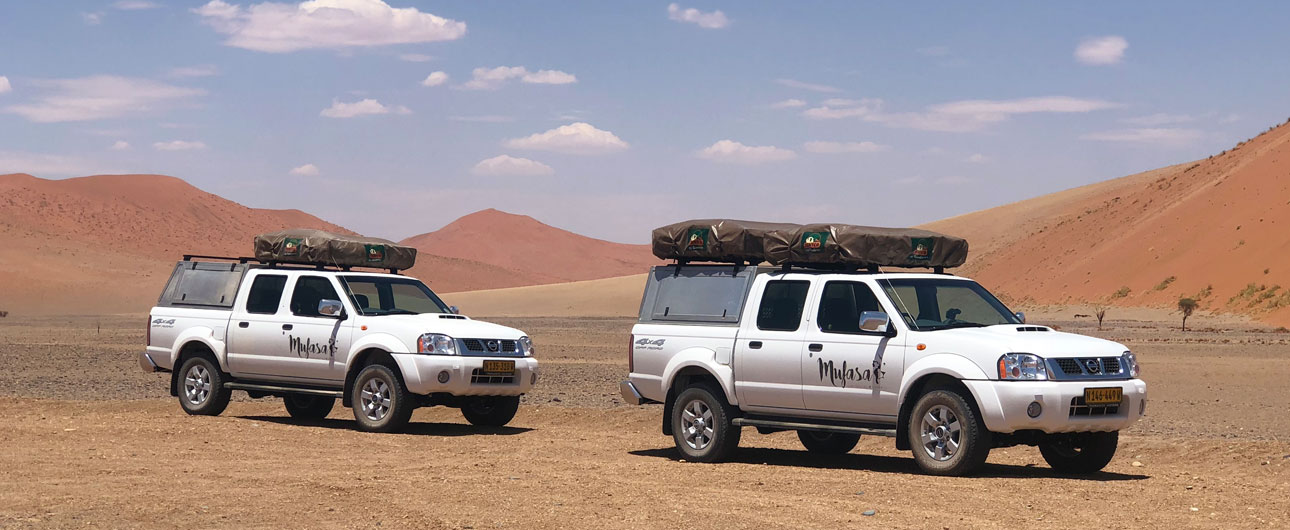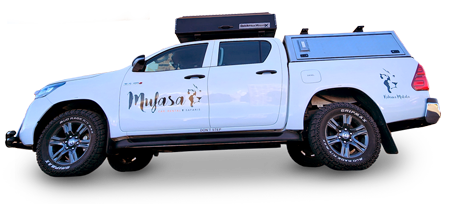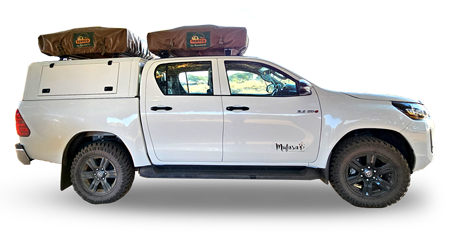



DISCOUNTED RATES
Travel Smart:
Low Season Car Rental Deals
when booking between November and June.
T&Cs apply
Is camping part of your itinerary in Namibia and\or Botswana? The Double Cab Nissan 4x4 is the most popular vehicle used for camping. The vehicle can fit up to 4 adults. The cars come equipped with a canopy, 1 or 2 double rooftop tents and the option of all the camping equipment needed to make your journey a comfortable and enjoyable experience. Assistance with itineraries and bookings is also available if required.

All our Toyota Hilux Double Cabs are fitted with canopies, 1 or 2 double rooftop tents and all essential camping equipment. Hardtop rooftop tents are available at an additional fee.
Our Toyota Hilux Double Cab can be enjoyed by up to 4 adults. The powerful 2.4L diesel engine and the extended long range 140L fuel tank will give you the freedom to explore even further.
Download additional information.
| Unlimited kilometres |
| N$250 (excl VAT) per additional driver once off |
| (Valid Drivers licence applicable | age 25 and older) |
| CarPlay |
| Air conditioner |
| Radio |
| 12V ports | Bluetooth | USB Ports |
| Electrical Fridge |
| Dual Battery System |
| Long range diesel fuel tank |
| 12V compressor |
| Lockable Canopy |
| 2 Spare tyres | Jack | Handle | Triangles |
| Electrical Fridge | Dual Battery System |
| Smash and grab window tint |

All our Toyota Hilux Double Cabs are fitted with canopies, 1 or 2 double rooftop tents, and all essential camping equipment. Hardtop rooftop tents are available at an additional fee.
Our Toyota Hilux Double Cab can be enjoyed by up to 4 adults. The powerful 2.4L diesel engine and the extended long range 140L fuel tank will give you the freedom to explore even further.
| Unlimited kilometres |
| N$250 (excl VAT) per additional driver once off |
| (Valid Drivers licence applicable | age 25 and older) |
| CarPlay |
| Air conditioner |
| Radio |
| 12V ports | Bluetooth | USB Ports |
| Electrical Fridge |
| Dual Battery System |
| Long range diesel fuel tank |
| 12V compressor |
| Lockable Canopy |
| 2 Spare tyres | Jack | Handle | Triangles |
| Electrical Fridge | Dual Battery System |

All our Toyota Hilux Double Cabs with automatic transmission, are fitted with canopies.
Our Toyota Hilux Double Cab can be enjoyed by up to 4 adults.
The powerful 2.4L diesel engine and the extended long range 140L fuel tank will give you the freedom to explore even further. It comes with multi-function steering wheel controls, an on-board computer and multi-information display.
| Unlimited kilometres |
| N$250 (excl VAT) per additional driver once off |
| (Valid Drivers licence applicable | age 25 and older) |
| Multi-function steering wheel |
| On-board computer and multi-information display |
| Air conditioner |
| Radio |
| 2 x 12V ports | Bluetooth | USB Ports |
| Electrical Fridge |
| Dual Battery System |
| Long range diesel fuel tank |
| 12V compressor |
| Central locking |
| Lockable canopy |
| ABS & Airbags |
| 2 Spare tyres | Jack / Handle / Triangles |
All vehicles are fitted with a Long Range Diesel Fuel Tank
Key Features of a Long Range Fuel Tank:
Please note that if the language on the license is not in English, and the license does not include a photo and signature, you will require an International Drivers' license.
Our vehicles are equipped with 1 or 2 double rooftop tents and all essential camping equipment.
They also include:  Fridge
Fridge  2 Spare Tyres.
2 Spare Tyres.
Camping equipment is packed according to PAX, up to and including 4 persons. Camping equipment for over 4 persons is charged as extra (chairs, sleeping bags, cutlery etc.).
For your peace of mind and the protection of your belongings, we have installed additional safety features in our vehicles.
The system includes an advanced alarm that will automatically sound under the following conditions:
This added layer of security is designed to deter theft and alert you immediately to any unauthorized access to your vehicle. We recommend always ensuring the canopy is properly locked when unattended and checking that the spare wheel is secure before setting off.
In Namibia we drive on the left side of the road. The roads vary considerably but are mostly uniformly well signposted in English. This makes self-driving in Namibia a preference.
We have 3 different types of road surfaces in Namibia:
National speed limits inside towns will vary between 40-60 kph whilst outside of town they will vary between 80-120 kph. These roads often have long straight sections. There are a few dangers to look out for. Game and livestock are mostly fenced off but could be found wandering in the road. The roads connect the main cities in Namibia and you will therefore find trucks travelling on the roads.
National travel speeds on these roads is an absolute maximum of 80 kph. They are usually fine for normal lower clearance 2WDs, but can be more difficult to drive due to the amount of traffic on the un-tarred road surface. You may encounter river crossings and mountain passes on these roads. These are hazardous areas for any car and you will be notified by warning signs along the road. We recommend that you reduce your speed on these sections. The gravel of these roads varies from coarse to fine sand and dust.
These roads are found at the coastal cities and the same recommendations as gravel roads apply. Their surfaces are a combination of salt water, gypsum, sand and/or gravel that is then baked in the sun. If they are wet, due to rain or heavy fog, which is a common occurrence near the coast, they can become slippery. For that reason, we urge car drivers to keep to a maximum speed of 80kph.
